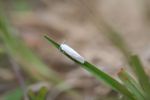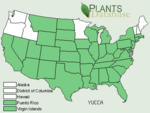Yucca
| Yucca |
|---|

|
| Scientific Classification |
|
| Species |
|
Y. aloifolia (Aloe yucca) Y. brevifolia (Joshua tree) Y. constricta (Buckley's yucca) Y. decipiens Y. filamentosa (Spoonleaf yucca or Filament yucca) Y. filifera (Palma Chuna yucca) Y. flaccida (Flaccid leaf yucca) Y. glauca (Great Plains yucca) Y. gloriosa (Moundlily yucca, Adam's needle, Spanish Dagger) Y. grandiflora (Sahuiliqui yucca) Y. harrimaniae (Harriman's yucca) Y. intermedia Y. jaliscensis (Izote) Y. kanabensis (Kanab yucca) Y. lacandonica (Tropical yucca) Y. madrensis (Soco yucca) Y. nana (Dwarf yucca) Y. pallida (Pale yucca) Y. periculosa (Izote) Y. recurvifolia (Curve-leaf yucca) Y. rigida (Blue yucca) Y. rostrata (Big Bend yucca) Y. rupicola (Texas yucca, or Twist-leaf yucca) Y. schidigera (Mojave yucca) Y. schottii (Hoary yucca or Mountain yucca) Y. standleyi Y. thompsoniana (Thompson's Yucca) Y. thornberi Y. torreyi (Torrey yucca) Y. treculiana (Texas bayonette, Trecul's yucca) Y. valida (Datilillo) Y. yucatana (Yucatan yucca) |
Yuccas are commonly misperceived as cacti. They grow in desert regions and have adapted by not requiring a large intake of water. They come in many different forms but the most common ones look like shrubs. A few yuccas also look like trees but not nearly as many as shrubs.
Anatomy
Yuccas are either trunkless shrubs that have rosettes of stiff leaves, that are in the shape of a sword, protruding out of the ground, or else they are in the shape of a tree with an obvious trunk and branches.[1]
Yucca leaves can be stiff, easily bent, or floppy. The spines on them can vary in many ways including: brown, yellow, white, straight, curved, curly, and some can even posses serrated leaves. At the tip of the leaf there may be a sharp or a blunt spine, or even no spine at all.[2]
Reproduction

Yuccas reproduce via seeds just like any other flowering plant, but the difference is in who pollinates it. The yucca is pollinated by the yucca moth. This moth is known to transfer the pollen from one yucca's stamens to the stigma of another yucca. When the moth does this, it lays an egg in the flower which hatches later and the larva eats lots of the forming seeds but not enough to effect its chances to reproduce.[3]
Ecology
Yuccas grow everywhere in southern and southwestern United States. Fifteen species of yucca are found in the deserts of the United States. Most of the yuccas do not grow high at all, this is because most yuccas are shrubs. Some yuccas get very large, like trees. Yuccas tend to grow in desert regions like Mexico and the southern and southwestern United States. [4]
Uses
The roots of the yucca plant are used for many things. The most common use for Yucca plants seems to be for hygiene. Yucca baccata's and Yucca glauca's roots are very useful for making soap. Their roots are pounded to remove extracts which are later tuned into shampoo and soap. Yuccas were also used by the Native Americans would tie a bunch of yucca fibers together and use it as a toothbrush or dental floss. They also used yucca soap to treat dandruff and hair loss.
Native Americans also used yuccas for many other purposes. This includes making cloth, belts, sandals, cords, mats, and baskets. Some Native American tribes still make these things out of yucca plants. These tribes include the Hopi, Papago, and Ute Indians.
Yuccas plants have a lot of medical uses as well. The main use is to treat arthritis, joint pain, and inflammation. The Native Americans used sap and mixed it into their baths to treat rashes, sprains, bleeding, and inflammation. To treat asthma and headaches, teas were made yucca and other herbs mixed together and brewed. It can also be used as an herbal dietary supplement.[5]
Gallery
Joshua Tree
(Y. decipiens)
References
- Yucca at Wikipedia
- The Yucca and Its Moth
- Benny's Yucca Page
- Yucca Plants
- USDA Plants




